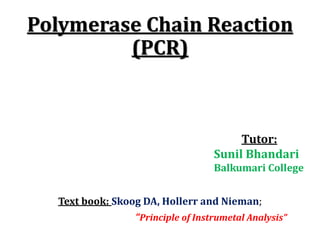Polymerase Chain Reaction (PCR)
- 1. Polymerase Chain Reaction (PCR) Text book: Skoog DA, Hollerr and Nieman; ŌĆ£Principle of Instrumetal AnalysisŌĆØ Tutor: Sunil Bhandari Balkumari College
- 4. PCR utilizes the two key properties of DNA At high temperature DNA becomes Single stranded (ssDNA) As temperature decreases, ssDNA becomes double stranded (dsDNA) ┬®▓§│▄▓įŠ▒▒¶▓·│¾▓╣▓į╗Õ▓╣░∙Š▒▒╣░¬▓Ą│Š▓╣Š▒▒¶.│”┤Ū│Š
- 7. Modern days instrument: full automation is gained ┬®▓§│▄▓įŠ▒▒¶▓·│¾▓╣▓į╗Õ▓╣░∙Š▒▒╣░¬▓Ą│Š▓╣Š▒▒¶.│”┤Ū│Š
- 8. 1. Introduction 2. Molecular revolution 3. Principle Part-1: PCR ┬®▓§│▄▓įŠ▒▒¶▓·│¾▓╣▓į╗Õ▓╣░∙Š▒▒╣░¬▓Ą│Š▓╣Š▒▒¶.│”┤Ū│Š
- 13. Temperature effect on PCR ┬®▓§│▄▓įŠ▒▒¶▓·│¾▓╣▓į╗Õ▓╣░∙Š▒▒╣░¬▓Ą│Š▓╣Š▒▒¶.│”┤Ū│Š
- 14. Part-2: PCR ŌĆó Requirements ŌĆó Instruments ŌĆó Procedures ŌĆó Applications ┬®▓§│▄▓įŠ▒▒¶▓·│¾▓╣▓į╗Õ▓╣░∙Š▒▒╣░¬▓Ą│Š▓╣Š▒▒¶.│”┤Ū│Š
- 15. Yellowstone National Park Thermus aquaticus ┬®▓§│▄▓įŠ▒▒¶▓·│¾▓╣▓į╗Õ▓╣░∙Š▒▒╣░¬▓Ą│Š▓╣Š▒▒¶.│”┤Ū│Š
- 18. If the sample is RNA An enzyme called ŌĆ£Reverse TranscriptaseŌĆØ is used in the reaction mixture, this will change the single stranded RNA in to its complementary DNA. ┬®▓§│▄▓įŠ▒▒¶▓·│¾▓╣▓į╗Õ▓╣░∙Š▒▒╣░¬▓Ą│Š▓╣Š▒▒¶.│”┤Ū│Š
- 21. Disadvantage of PCR 1.Target DNA sequence must be known 2.Errors of Taq-polymerase 3.Size limitation (CG triplet repeats) 4.Instrumental cost is high ŌĆóSetting up and running requires high skills ┬®▓§│▄▓įŠ▒▒¶▓·│¾▓╣▓į╗Õ▓╣░∙Š▒▒╣░¬▓Ą│Š▓╣Š▒▒¶.│”┤Ū│Š






















